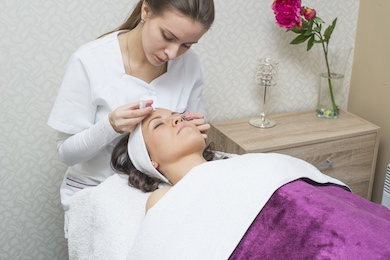
Acne is one of the most prevalent skin issues in the U.S., and it’s on the rise. Today, there are nearly 60 million Americans with active acne and 20 million are at risk of developing scar tissue as a result. According to research conducted in 2016, 85% of individuals surveyed battled acne at some point in their lives.
There is a tremendous need –– and it only continues to grow –– to help clients treat acne and bring skin back to optimal health. Beyond the skin, acne is also linked to reduced self esteem, depression and anxiety –– another motivating factor to help clients achieve healthy, smooth skin.
In this two part series, we’ll explore the growing acne market, triggers behind acne, and ways to help support clients in the treatment of acne.
Correcting a growing issue
Acne has seemingly always been prevalent among teenagers. Most come to expect it as they enter puberty, however acne is now spreading on both sides of the spectrum. According to a recent study, it is impacting individuals at increasingly younger ages ––many under 13 –– and to approximately 20 percent more young people than in years past.
Of course, many of us know it’s not just teens and pre-teens who battle acne. Over the past 10 years, the average age of an acne sufferer has increased from approximately 20 years old to 26 years old. And approximately 25% of adult men and 50% of adult women still experience acne.
Naturally, as the need has increased, so too has the market growth. Today, Americans spend millions annually on acne treatment and the acne market is expected to grow 4.6% each year.
What has led to the acne surge?
While there are many theories as to the exact cause of acne, we do know there are a number of triggers including, hormonal imbalances, nutrient deficiencies, medications, stress, not cleansing the skin properly, and genetics. It’s a challenge to trace the increase in acne back to one root cause, but it could be an overall rise in stress levels, pollutants in the environment, and various ingredients found in many of our food sources and cosmetics that have been linked to hormone imbalances.
As aesthetic professionals, it’s part of our job to properly diagnosis the root cause before we can outline the best course of treatment. With that in mind, let’s take a closer look at some of the common acne triggers:
Hormones – oil production is regulated heavily by hormones, specifically testosterone, which stimulates the development of sebaceous follicles and attached oil glands. This explains why acne is most common during puberty, pregnancy, menstrual cycles and menopause. Because of this, women are five times more prone to acne later in life than men.
Stress – stress is one of the top triggers of acne as it stimulates the adrenal glands to produce more cortisol, which can cause excess sebum and inflammation. Acne flare-ups can occur within 14 days to a month after the stress response.
Medication – the hormones (adrenals) may be affected by some medications and drug use and can spur on blemishes.
Nutrition and diet – alcohol, caffeine and foods with iodides (salt, processed and fast foods, MSG, dairy in excess) can trigger existing acne. When foods high in starch or sugar are consumed, it can spike insulin, and some research suggests that this can also instigate sebum production. It’s worth talking to clients about eating an organic diet when possible to eliminate the possibility of foods that may contain hormones, preservatives or pesticides, as these can all have adverse effects on the skin.
Improper cleansing– when oil builds up on the skin, bacteria will form, which creates blemishes. Sleeping in make-up along with exposure to debris from the day sets up a perfect opportunity for more bacteria. Teaching your clients to cleanse properly and regularly will often eliminate their acne issues.
Skin irritants – detergents, fabric softeners, certain shampoos and conditioners, and fragrances or dyes can irritate existing acne conditions.
Picking – improper squeezing, picking and inept extractions may rupture the follicle wall causing bacteria to spread. It may also lead to deeper impaction and scarring. Educate clients about icing as a way to reduce inflammation as soon as they feel the pressure of a lesion. In the treatment room and at home, icing can be very valuable.
Over stripping the skin – overuse of certain drying skin care products may cause the skin to over-produce sebum. This is because the skin needs a healthy level of oils, however when it is stripped of all oils, the responder will start to produce more, which can then get trapped and cause more bacteria.
Genetics – some may be predisposed to acne based on certain genes that are passed along, but it’s believed it is polygenic, or a grouping of genes as opposed to one singular gene.
As you can see there are numerous triggers behind acne, so the most important thing is to get a dialogue going with your clients. The goal is to try to get to the root cause by understanding their skin histology, as well as their lifestyle. With this insight, you’ll be better able to map out the best course of treatment.
In the next post, we’ll look at the types of acne and best ways to treat them. Hint: effective treatment can be boiled down to three key steps.
Question: Have you experienced an increase in acne cases among your clients?
